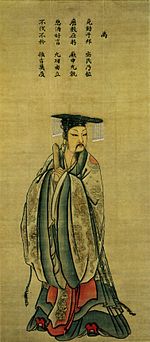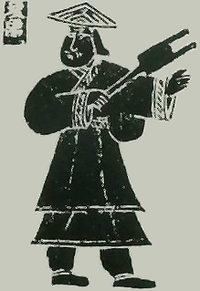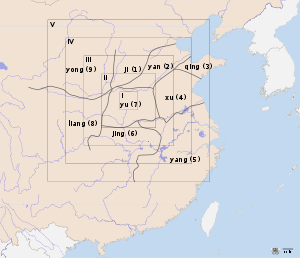- Yu the Great
-
Yu the Great 
Yu the Great, Color on silk at the National Palace Museum Chinese 大禹 Transcriptions Mandarin - Hanyu Pinyin Dà Yǔ Min - Hokkien POJ Daí Wu Cantonese (Yue) - Jyutping Daai6 Yu5 Yu the Great (Chinese: 大禹; pinyin: Dà Yǔ, c. 2200 - 2100 BC),[1] was a legendary ruler of Ancient China famed for his introduction of flood control, inaugurating dynastic rule in China by founding the Xia Dynasty, and for his upright moral character.[2][3]
Few, if any, records exist from the period of Chinese history when Yu reigned. Because of this, the vast majority of information about his life and reign comes from collected pieces of oral tradition and stories that were passed down in various areas of China, many of which were collected in Sima Qian's famous Records of the Grand Historian. Yu and other "sage-kings" of Ancient China were lauded by Confucius and other Chinese teachers, who praised their virtues and morals.[4]
Yu is one of the few Chinese rulers posthumously honored with the appellation "the Great".
Contents
Ancestry and early life
Main article: Chinese emperors family tree (ancient)According to several ancient Chinese records, Yu was the 8th great-grandson of the Yellow Emperor: Yu's father Gun was the 5th great-grandson of King Zhuanxu; Zhuanxu's father Changyi was the second son of the Yellow Emperor.[5][6][7][8] Yu was said to be born at Mount Wen (Chinese: 汶山), in modern day Beichuan County, Sichuan Province,[9] though there are debates as to whether he was born in Shifang instead.[10] Yu's mother was a woman of the Youxin clan named either Nüzhi (Chinese: 女志) or Nüxi (Chinese: 女嬉).
As a child, Yu's father Gun moved the people east toward the Chinese heartland. King Yao enfeoffed Gun as lord of Chong, usually identified as the middle peak of Mount Song. Yu is thus believed to have grown up on the slopes of Mount Song, just south of the Yellow River.[11] He later married a woman from Mount Tu (Chinese: 塗山) who is generally referred to as Tushan-shi (Chinese: 塗山氏; literally "Lady Tushan").[12] They had a son named Qi, a name literally meaning "revelation".[12]
Great Yu Controls the Waters


Han Dynasty depiction of Yu. Main article: Great Flood (of China)During the reign of king Yao, the Chinese heartland was frequently plagued by floods that prevented further economic and social development.[13] Yu's father, Gun, was tasked with devising a system to control the flooding. He spent nine years building a series of dikes and dams along the riverbanks, but they were ineffective. As an adult, Yu continued his father's work and made a careful study of the river systems in an attempt to learn why his father's efforts had failed.
Collaborating with Houji - a semi-mythical agricultural master about whom little is concretely known - Yu successfully devised a system of flood controls that were crucial in establishing the prosperity of the Chinese heartland. Instead of directly damming the rivers' flow, Yu made a system of irrigation canals that relieved floodwater into fields, as well as spending great effort dredging the riverbeds.[7] Yu is said to have eaten and slept with the common workers and spent most of his time personally assisting the work of dredging the silty beds of the rivers for the 13 years the projects took to complete. The dredging and irrigation were successful, and allowed ancient Chinese culture to flourish along the Yellow River, Wei River, and other waterways of the Chinese heartland. The project earned Yu renown throughout Chinese history, and is referred to in Chinese history as "Great Yu Controls the Waters" (Chinese: 大禹治水; pinyin: Dà Yǔ Zhì Shuǐ). In particular, Mount Longmen along the Yellow River had a very narrow channel which blocked water from flowing freely east toward the ocean. Yu is said to have brought a large number of workers to open up this channel, which has been known ever since as "Yu's Gateway" (Chinese: 禹門口).[7]
Apocryphal stories
In a mythical version of this story, presented in Wang Jia's 4th century AD work Shi Yi Ji, Yu is assisted in his work by a yellow dragon and a black turtle (not necessarily related to the Black Tortoise of Chinese mythology).[14] Another local myth says that Yu created the Sanmenxia "Three Passes Gorge" of the Yangzi River by cutting a mountain ridge with a divine battle-axe to control flooding.[15]
Traditional stories say that Yu sacrificed a great deal of his body to control the floods. For example, his hands were said to be thickly callused, and his feet were completely covered with callus. In one common story, Yu had only been married only four days when he was given the task of fighting the flood. He said goodbye to his wife, saying that he did not know when he would return. During the 13 years of flooding, he passed by his own family's doorstep three times, but each time he did not return inside his own home. The first time he passed, he heard that his wife was in labor. The second time he passed by, his son could already call out to his father. His family urged him to return home, but he said it was impossible as the flood was still going on. The third time Yu was passing by, his son was older than 10 years old. Each time, Yu refused to go in the door, saying that as the flood was rendering countless numbers of people homeless, he could not rest.[12][16]
The Nine Provinces
King Shun, who reigned after his father Yao, was so impressed by Yu's engineering work and diligence that he passed the throne to Yu instead of to his own son. Yu is said to have initially declined the throne, but was so popular with other local lords and chiefs that he agreed to become the new emperor, at the age of 53. He established a capital at Anyi (Chinese: 安邑) - the ruins of which are in modern Xia County, in southern Shanxi Province - and founded what would be called the Xia Dynasty, traditionally considered China's first dynasty.[17]
Yu's flood control work is said to have made him intimately familiar with all regions of what was then Han Chinese territory. According to the Book of History, Yu divided the Chinese "world" into nine zhou or provinces. These were Jizhou (冀州), Yanzhou (兗州), Qingzhou (青州), Xuzhou (徐州), Yangzhou (揚州), Jingzhou (荊州), Yuzhou (豫州), Liangzhou (梁州) and Yongzhou (雍州).[18]
According to the Rites of Zhou there was no Xuzhou or Liangzhou, instead there was Youzhou (幽州) and Bingzhou (并州), but according to the Erya there was no Qingzhou or Liangzhou, instead there was Youzhou (幽州) and Yingzhou (營州).[18] Either way there were nine divisions. Once he had received bronze from these nine territories, he created ding vessels called the Nine Tripod Cauldrons.[19] Yu then established his capital at Yang City (陽城).[20] According to the Bamboo Annals, Yu killed one of the northern leaders, Fangfeng (防風) to reinforce his hold on the throne.[21][22]
Death
According to the Bamboo Annals, Yu ruled the Xia Dynasty for 45 years, and according to Yue Jueshu (越絕書), he died of an illness.[22][23] It is said that he died at Kuaiji Mountain (會稽山), south of present day Shaoxing, while on a hunting tour to the eastern frontier of his empire, and was buried there. The Yu mausoleum (大禹陵) known today was first built in the 6th century CE during the Southern dynasty in his honor.[24] It is located four kilometers southeast of Shaoxing city.[24] Most of the structure was rebuilt many times in later periods. The three main parts of the mausoleum are the Yu tomb (禹陵), temple (禹廟) and memorial (禹祠).[25] In many statues he is seen carrying an ancient plow (耒耜). A number of emperors in imperial times have travelled there to perform ceremonies in his honor, notably Qin Shi Huang.[23]
Society influence
Modern
In the Republic of China era Sun Yat-sen envisioned great plans for water control like Yu the Great including a 30 million horsepower dam across the Yangtze River.[26] However the plans did not come into being as the Kuomintang were at war with Japan and the Communist Party of China.[26][27]
Beichuan, Wenchuan and Dujiangyan towns in Sichuan have all made claims to be the birthplace of Yu the great.[28]
In popular culture
Yu, played by Vince Crestejo, is the eldest of the System Lords, as seen in the science fiction television series Stargate SG-1. He did not assume the role of a god, but rather one of China's earliest emperors, and is notable for several positive influences made during his reign. In the show, he has been introduced as Yu the Great in Fair Game, and the Jade Emperor, the exalted Yu Huang Shang Ti in Summit, who are separate figures in Chinese mythology.
See also
- Chinese emperors family tree (ancient)
- Flood myth
- Great Flood (China)
- Natural disasters in China
References
- ^ Wang Quangen 王泉根, (1993). Huaxia Quming Yishu 華夏取名藝術. (Taipei: Zhishu-fang Chuban Jituan 知書房出版集團), 42.
- ^ Mungello, David E. The Great Encounter of China and the West, 1500–1800 Rowman & Littlefield; 3 edition (28 Mar 2009) ISBN 978-0742557987 p.97 [1]
- ^ 戴逸, 龔書鐸. [2002] (2003) 中國通史. 史前 夏 商 西周. Intelligence press. ISBN 9628792806. p 40.
- ^ 戴逸, 龔書鐸. [2002] (2003) 中國通史. 史前 夏 商 西周. Intelligence press. ISBN 9628792806. p 36.
- ^ Book of Han (律曆志) chapter
- ^ Book of Lineages (世本)
- ^ a b c 戴逸, 龔書鐸. [2002] (2003) 中國通史. 史前 夏 商 西周. Intelligence press. ISBN 9628792806. p 38.
- ^ Zynews.com. "Zynews.com." Xia dynasty brief history. Retrieved on 2010-09-18.
- ^ "Jiangsu.gov.cn." 四川省汶川縣情及人文地理. (Chinese) Retrieved on 2010-09-18.
- ^ Scta.gov.cn. "Scta.gov.cn." (Chinese) Retrieved on 2010-09-18.
- ^ Hubeiwater.gov.cn. Hubeiwater.gov.cn 大禹三过家门而不入与洪湖抗洪十字歌的精神浅谈. (Chinese). Retrieved on 2010-09-18.
- ^ a b c Wang Hengwei 王恆偉. (2006) Zhongguo Lishi Jiangtang 中國歷史講堂 #1 Yuan Gu Zhi Chunqiu 遠古至春秋. Zhonghua Shuju 中華書局. ISBN 962-8885-24-3. p 18.
- ^ Lu, Xing. Rhetoric in ancient China, fifth to third century, B.C.E.: a comparison with classical Greek rhetoric. [1998] (1998). Univ of South Carolina Press publishing. ISBN 1570032165, 9781570032165. p 46–47.
- ^ Lewis, Mark Edward (2006), The flood myths of early China, SUNY series in Chinese philosophy and culture, SUNY Press, pp. 104–105, 191–192, ISBN 0791466639, http://books.google.com.au/books?id=6yCq-NEdKeUC (especially, notes 90 and 97). The relevant text is in Shi Yi Ji, Chapter 2: "黃龍曳尾於前,玄龜負青泥於後", etc.
- ^ Destguides.com. "Destguides.com." Sanmenxia. Retrieved on 2010-09-26.
- ^ 王恆偉. (2005) (2006) 中國歷史講堂 #1 遠古至春秋. 中華書局. ISBN 962-8885-24-3. p 19.
- ^ 王恆偉. (2005) (2006) 中國歷史講堂 #1 遠古至春秋. 中華書局. ISBN 962-8885-24-3. p 21.
- ^ a b Ng Saam-sing 吾三省. (2008). Zong-guok Man-faa Bui-ging Bat-cin Ci 中國文化背景八千詞. Hong Kong: Seong Mou Jan Syu Gwun 商務印書館(香港). ISBN 9620718461, 9789620718465. p 37.
- ^ Bjaaland Welch, Patricia. [2008] (2008). Chinese art: a guide to motifs and visual imagery. Tuttle Publishing. ISBN 080483864X, 9780804838641. p 262.
- ^ 李玉潔. [2003] (2003). 中國早期國家性質. 知書房出版集團. ISBN 9867938178, 9789867938176.
- ^ 王仲孚. [1996] (1996). 中國上古史專題研究. 五南圖書出版股份有限公司. ISBN 9571112909, 9789571112909. p 392.
- ^ a b Bamboo Annals Xia chapter
- ^ a b Chinaculture.org. "Chinaculture.org." 大禹祭典. Retrieved on 2010-09-26.
- ^ a b China.org.cn. "China.org.cn." Yu Mausoleum. Retrieved on 2010-09-26.
- ^ lvyou.eco.gov.cn. "lvyou.eco.gov.cn." 治水英雄大禹的葬地:大禹陵. Retrieved on 2010-09-26.
- ^ a b Yan, Hong-Sen. [2007] (2007). Reconstruction designs of lost ancient Chinese machinery Volume 3 of History of mechanism and machine science. ISBN 1402064594, 9781402064593. p 48.
- ^ From 1994 to 2008 the Three Gorges Dam was built on the Yangtze River
- ^ Sichuan.scol.com.cn. "Scol.com.cn." 发现西羌古道有关遗迹大禹故乡迷雾更浓 . Retrieved on 2010-09-26.
Yu the GreatRegnal titles Preceded by
ShunKing of China
traditionally 2205 BCE – 2197 BCESucceeded by
QiList of Sovereigns of Xia Yu the Great 大禹 • Qi 启 • Tai Kang 太康 • Zhong Kang 仲康 • Xiang 相 • Shaokang 少康 • Zhu 杼 • Huai 槐 • Máng 芒 • Xie 泄 • Bu Jiang 不降 • Jiong 扃 • Jin 廑 • Kong Jia 孔甲 • Gao 皋 • Fa 發 • Jie 桀
Categories:- Chinese mythology
- Flood myths
- 22nd-century BC rulers
- Xia Dynasty kings
- Xia Dynasty
Wikimedia Foundation. 2010.

